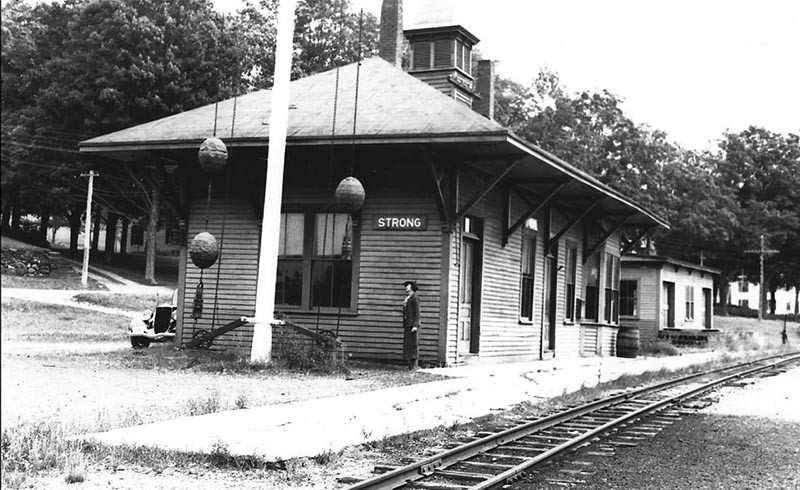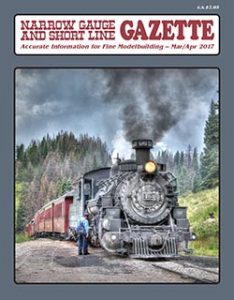 by Peter S. Barney/photos as noted
by Peter S. Barney/photos as noted
Bob Brown wrote a review of an O scale, River Leaf Models, ball signal kit in the September/October 2016 GAZETTE. I purchased three of these kits, and after I had assembled them, added the ball signals to my On2 layout. Having done this, I thought that GAZETTE readers might be interested in some information on the ball signals that were used on the 2-foot gauge Sandy River & Rangeley Lakes Railroad. Their prototype signals were slightly different from the River Leaf models, in that the bottom pulleys were mounted on downward slanting metal brackets, instead of wooden horizontal ones.
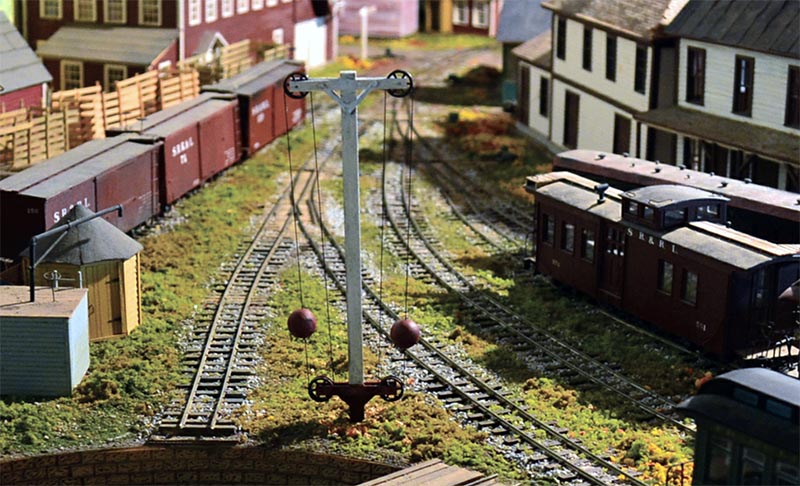
This ball signal is located near the Phillips turntable on the author’s On2 layout.
Ball signals were used to protect track crossings and yard movements on many 19th Century railroads – and well into the 20th century on some. The Sandy River & Rangeley Lakes Railroad had ball signals at Farmington, Strong, and Phillips. The Farmington signal protected the crossing where the 2-foot gauge crossed the Maine Central. The Strong signal protected trains entering the yard from the north and south by indicating which train had the right-ofway. The Phillips ball signal was located near the turntable, and governed train movements into the yard.
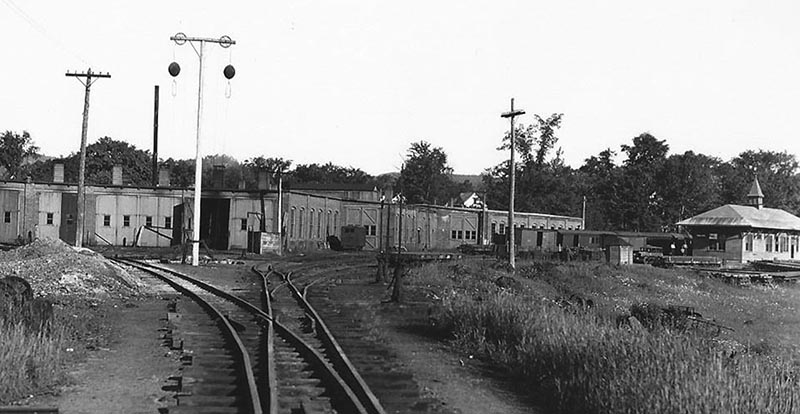
Linwood Moody took this photo in 1935 showing the ball signal at Phillips station with two balls. Linwood Moody photo, author’s collection
The balls on a ball signal could be arranged in several different ways: If they had two balls – either or both could be down – or both up – or a ball up or down – on one side or the other. Or they could have two balls on one side and one on the other. On occasion, lanterns were attached to the bottom of the balls for night operations.
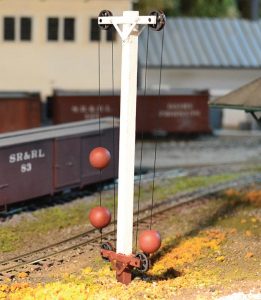 The ball signal at Farmington originally had two balls, but at some unknown time, the ball nearest the 2-foot gauge track was removed, and after that, the signal only had a pulley arrangement on the Maine Central’s side. By modeling the Farmington ball signal in this manner, I had an extra ball left over for the Strong signal, which had two balls on one side, and one on the other.
The ball signal at Farmington originally had two balls, but at some unknown time, the ball nearest the 2-foot gauge track was removed, and after that, the signal only had a pulley arrangement on the Maine Central’s side. By modeling the Farmington ball signal in this manner, I had an extra ball left over for the Strong signal, which had two balls on one side, and one on the other.
Photos of the two-ball signal taken at Farmington about 1915 show the remaining top pulley, but no hanging ball, and no bottom pulley.
The Strong ball signal was originally located south of the depot. At some time, perhaps after the collision between numbers 7 and 16, the signal was moved north of the depot, nearer to the junction turnout. This collision happened on July 8, 1916, when the ball arrangement was changed while two trains were entering the yard, giving both train crews an apparent “go ahead” as they viewed the signal while looking away from the approaching yard. Number 7, pulling a 6 car passenger train, coming down from Phillips, slid into #16 as she pulled a freight train from Kingfield.
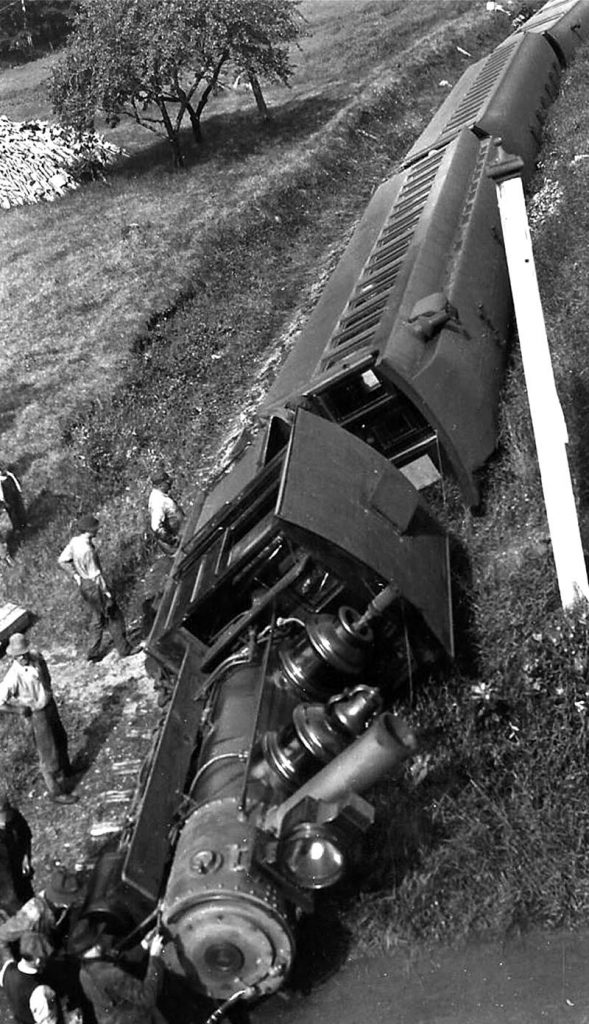 Number 7’s crew had spied the ball signal through an opening in the trees (main-tained by the railroad) across the curve coming into the yard. The signal was set with one ball for #7 to enter, but as the train was entering, and the signal was hidden from sight, the agent was in the process of changing the balls to three balls, allowing the freight train into the yard. And so, both trains, “seeing” each other, slammed on the brakes, and slowly came together, tipping the entire passenger train on its side. The resulting relocation of the ball signal to north of the depot, closer to the junction turnout, apparently prevented another accident.
Number 7’s crew had spied the ball signal through an opening in the trees (main-tained by the railroad) across the curve coming into the yard. The signal was set with one ball for #7 to enter, but as the train was entering, and the signal was hidden from sight, the agent was in the process of changing the balls to three balls, allowing the freight train into the yard. And so, both trains, “seeing” each other, slammed on the brakes, and slowly came together, tipping the entire passenger train on its side. The resulting relocation of the ball signal to north of the depot, closer to the junction turnout, apparently prevented another accident.
The Phillips ball signal had one ball on each side, and train movements were determined by which ball was raised. There was also a semaphore signal located north of the depot, visible to trains coming down the Phillips & Rangeley Railroad tracks.
 This article appeared in the March/April 2017 issue of the Narrow Gauge & Shortline Gazette
This article appeared in the March/April 2017 issue of the Narrow Gauge & Shortline Gazette


